Porter’s Value Chain Model: Assessing the Internal Environment of Tesco
VerifiedAdded on 2023/01/11
|9
|2710
|1
AI Summary
This report details the application of Porter’s Value Chain Model to assess the internal environment of Tesco, a multinational retail giant. It explores the value adding services and operations of Tesco and reflects on the usefulness of the model.
Contribute Materials
Your contribution can guide someone’s learning journey. Share your
documents today.

Reflective Account
Secure Best Marks with AI Grader
Need help grading? Try our AI Grader for instant feedback on your assignments.
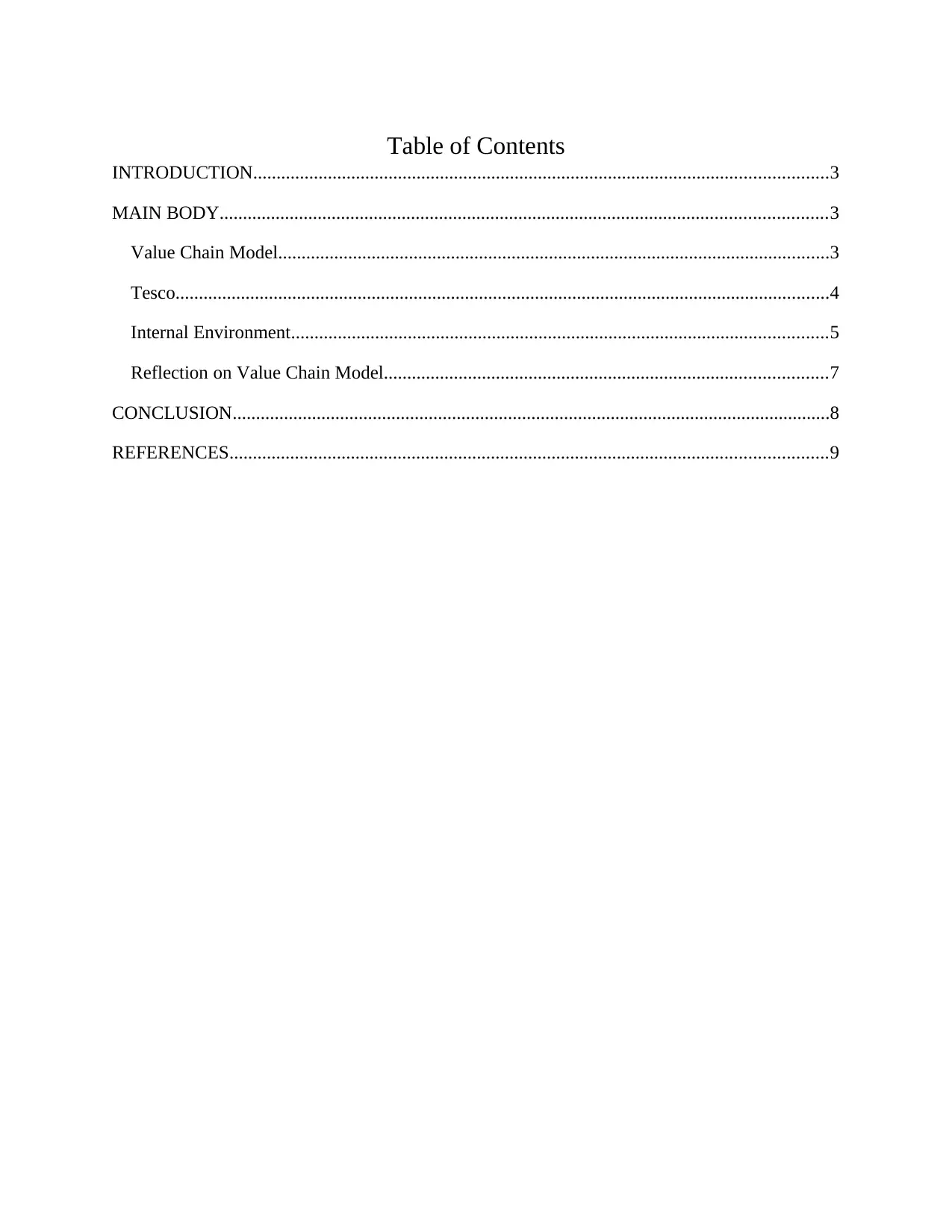
Table of Contents
INTRODUCTION...........................................................................................................................3
MAIN BODY..................................................................................................................................3
Value Chain Model......................................................................................................................3
Tesco............................................................................................................................................4
Internal Environment...................................................................................................................5
Reflection on Value Chain Model...............................................................................................7
CONCLUSION................................................................................................................................8
REFERENCES................................................................................................................................9
INTRODUCTION...........................................................................................................................3
MAIN BODY..................................................................................................................................3
Value Chain Model......................................................................................................................3
Tesco............................................................................................................................................4
Internal Environment...................................................................................................................5
Reflection on Value Chain Model...............................................................................................7
CONCLUSION................................................................................................................................8
REFERENCES................................................................................................................................9
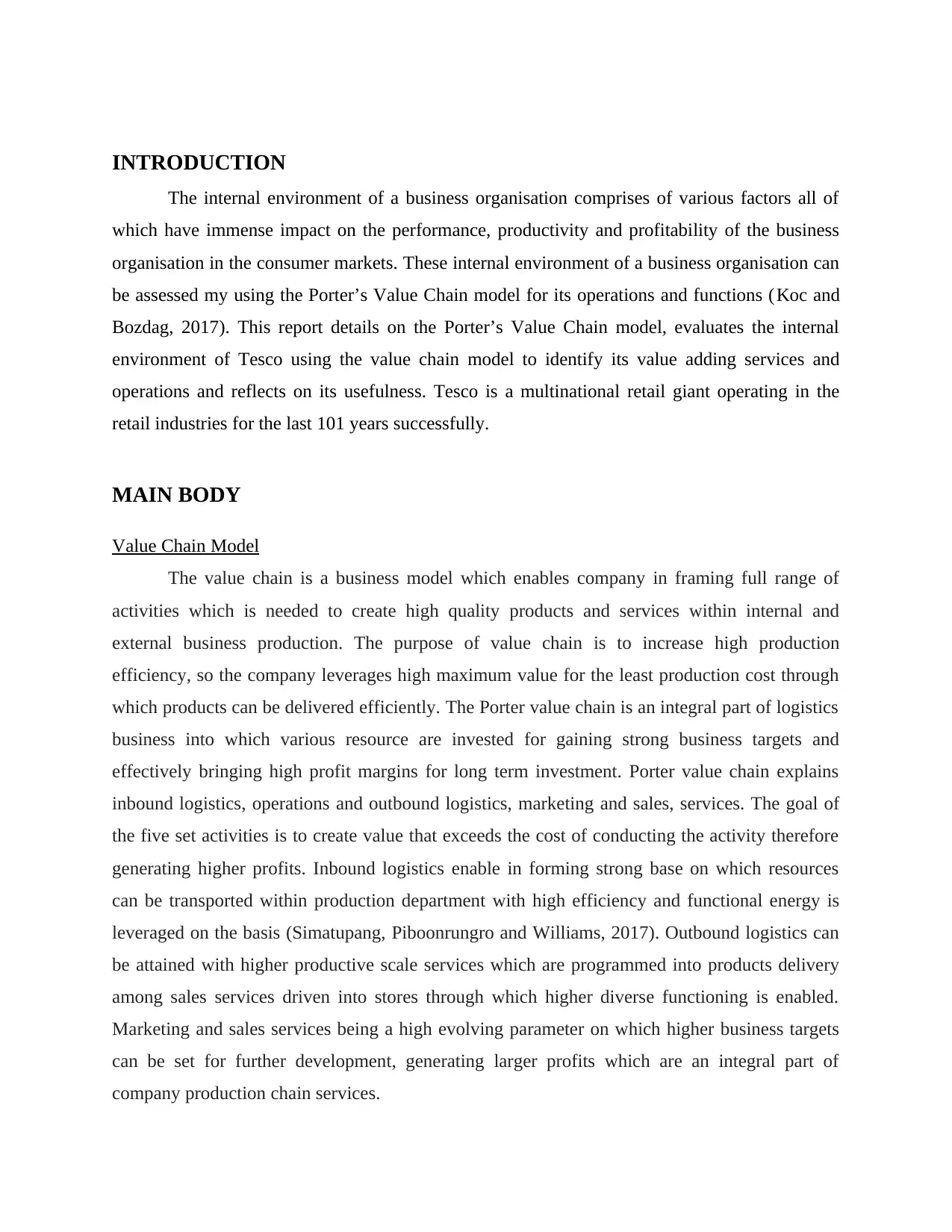
INTRODUCTION
The internal environment of a business organisation comprises of various factors all of
which have immense impact on the performance, productivity and profitability of the business
organisation in the consumer markets. These internal environment of a business organisation can
be assessed my using the Porter’s Value Chain model for its operations and functions (Koc and
Bozdag, 2017). This report details on the Porter’s Value Chain model, evaluates the internal
environment of Tesco using the value chain model to identify its value adding services and
operations and reflects on its usefulness. Tesco is a multinational retail giant operating in the
retail industries for the last 101 years successfully.
MAIN BODY
Value Chain Model
The value chain is a business model which enables company in framing full range of
activities which is needed to create high quality products and services within internal and
external business production. The purpose of value chain is to increase high production
efficiency, so the company leverages high maximum value for the least production cost through
which products can be delivered efficiently. The Porter value chain is an integral part of logistics
business into which various resource are invested for gaining strong business targets and
effectively bringing high profit margins for long term investment. Porter value chain explains
inbound logistics, operations and outbound logistics, marketing and sales, services. The goal of
the five set activities is to create value that exceeds the cost of conducting the activity therefore
generating higher profits. Inbound logistics enable in forming strong base on which resources
can be transported within production department with high efficiency and functional energy is
leveraged on the basis (Simatupang, Piboonrungro and Williams, 2017). Outbound logistics can
be attained with higher productive scale services which are programmed into products delivery
among sales services driven into stores through which higher diverse functioning is enabled.
Marketing and sales services being a high evolving parameter on which higher business targets
can be set for further development, generating larger profits which are an integral part of
company production chain services.
The internal environment of a business organisation comprises of various factors all of
which have immense impact on the performance, productivity and profitability of the business
organisation in the consumer markets. These internal environment of a business organisation can
be assessed my using the Porter’s Value Chain model for its operations and functions (Koc and
Bozdag, 2017). This report details on the Porter’s Value Chain model, evaluates the internal
environment of Tesco using the value chain model to identify its value adding services and
operations and reflects on its usefulness. Tesco is a multinational retail giant operating in the
retail industries for the last 101 years successfully.
MAIN BODY
Value Chain Model
The value chain is a business model which enables company in framing full range of
activities which is needed to create high quality products and services within internal and
external business production. The purpose of value chain is to increase high production
efficiency, so the company leverages high maximum value for the least production cost through
which products can be delivered efficiently. The Porter value chain is an integral part of logistics
business into which various resource are invested for gaining strong business targets and
effectively bringing high profit margins for long term investment. Porter value chain explains
inbound logistics, operations and outbound logistics, marketing and sales, services. The goal of
the five set activities is to create value that exceeds the cost of conducting the activity therefore
generating higher profits. Inbound logistics enable in forming strong base on which resources
can be transported within production department with high efficiency and functional energy is
leveraged on the basis (Simatupang, Piboonrungro and Williams, 2017). Outbound logistics can
be attained with higher productive scale services which are programmed into products delivery
among sales services driven into stores through which higher diverse functioning is enabled.
Marketing and sales services being a high evolving parameter on which higher business targets
can be set for further development, generating larger profits which are an integral part of
company production chain services.

Tesco being one of the biggest company uses porter value chain as the functional asset
through which products are delivered effectively to customers as per their preferences and
impactful time periods which builds goodwill. There is high competitiveness among companies
in retail industry under which Tesco aims to effectively build strong image of itself by focusing
towards high ethical and productive distribution of services. The porter value chain is strong
primary asset for company on which various operational efficiency tools are based for company
strong sustainable business extension, expansion into international periods through which large
diversity generates. This chain enables in structuring strategic planning towards logistics
business through which higher profits can be generated with innovative technology, potential
development and relative cost effective services (Lincoln and Andrew, 2018). The chain is
vitally used in logistics of company Tesco where business is highly focused towards generating
functional chains of products, services of strong quality standards and production being highly
effective. Tesco being one of the biggest retailer company aims to integrate quality management
within its supply value chain of operational services through which customers can be brought
closer to brand services with fast impactful delivery services.
Tesco
Tesco is a multinational retail business organisation that specialises in retailing general
merchandise and groceries to its consumers in the retail markets. Tesco was founded in 1919, an
astonishing 101 years ago and currently operates from its headquarters in Hertfordshire, England.
Having successfully operated in the UK’s retail markets for such a long period of time has
presented Tesco with ample opportunities to grow and expand their business operations to global
markets in an attempt to diversify their operations and increase their customer base, markets
share, productivity and profitability in the retail markets. Currently Tesco operates around 6800
distinct establishments across 11 different countries of the world and employs around half a
million individuals for its various and diverse operations (Johnson and et.al., 2018). As Tesco
has such diversified operations in many countries, it enjoys considerable financial safety owing
to its large customer base and well built infrastructure within the retail industries. Through its
operations Tesco has grown to become the world’s third largest retail on the basis of tis gross
revenues generated and the world’s ninth largest retailer on the basis of revenues generated by its
operations. Tesco has also grown to become the market leader in the UK’s retail markets owing
to its largest market share of 28.4% amongst all business organisations operating in the UK’s
through which products are delivered effectively to customers as per their preferences and
impactful time periods which builds goodwill. There is high competitiveness among companies
in retail industry under which Tesco aims to effectively build strong image of itself by focusing
towards high ethical and productive distribution of services. The porter value chain is strong
primary asset for company on which various operational efficiency tools are based for company
strong sustainable business extension, expansion into international periods through which large
diversity generates. This chain enables in structuring strategic planning towards logistics
business through which higher profits can be generated with innovative technology, potential
development and relative cost effective services (Lincoln and Andrew, 2018). The chain is
vitally used in logistics of company Tesco where business is highly focused towards generating
functional chains of products, services of strong quality standards and production being highly
effective. Tesco being one of the biggest retailer company aims to integrate quality management
within its supply value chain of operational services through which customers can be brought
closer to brand services with fast impactful delivery services.
Tesco
Tesco is a multinational retail business organisation that specialises in retailing general
merchandise and groceries to its consumers in the retail markets. Tesco was founded in 1919, an
astonishing 101 years ago and currently operates from its headquarters in Hertfordshire, England.
Having successfully operated in the UK’s retail markets for such a long period of time has
presented Tesco with ample opportunities to grow and expand their business operations to global
markets in an attempt to diversify their operations and increase their customer base, markets
share, productivity and profitability in the retail markets. Currently Tesco operates around 6800
distinct establishments across 11 different countries of the world and employs around half a
million individuals for its various and diverse operations (Johnson and et.al., 2018). As Tesco
has such diversified operations in many countries, it enjoys considerable financial safety owing
to its large customer base and well built infrastructure within the retail industries. Through its
operations Tesco has grown to become the world’s third largest retail on the basis of tis gross
revenues generated and the world’s ninth largest retailer on the basis of revenues generated by its
operations. Tesco has also grown to become the market leader in the UK’s retail markets owing
to its largest market share of 28.4% amongst all business organisations operating in the UK’s
Secure Best Marks with AI Grader
Need help grading? Try our AI Grader for instant feedback on your assignments.

retail markets. Owing to its immense financial success in the retail markets of the world, Tesco
also owns and operates various other smaller subsidiaries such as Tesco Stores Ltd., Tesco
mobile, Tesco Bank, Tesco Family Dining Ltd., Jack’s, Booker Group, Dunnhumby and
Spenhill. Tesco’s operations in the fiscal year of 2019 were significantly successful, with the
retail giants generating total revenues of around £63.911 billion Euros and a net income of
around £1.320 billion Euros.
Internal Environment
The Porter’s Value Chain model specifies 5 primary activities that comprise a business’s
internal environment in addition to several secondary activities support the operations of the
business’s primary activities in addition to providing it with value. Application of Porter’s value
chain model to Tesco’s operations is as follows:
Primary Activities:
Inbound Logistics: The inbound logistics of Tesco include various supply operations of
thousands of goods, products and raw materials which are required for its operations. As Tesco’s
operations are spread around the entire world, their inbound logistical operations have to perform
effectively and efficiently so that the distinct establishments of Tesco can operate successfully
(Vardar, 2018). For this Tesco makes use of the principle of economies of scale to procure goods
and raw materials in bulk quantities from suppliers so that they can drive the cost of their
products low. Tesco invested in logistical trailers with improved carrying capacity compared to
their older trailers with this investment resulting in increased logistical performance by 13%.
Operations: The operations conducted by Tesco are varied with its operations consisting of
retail, manufacturing and banking functions. Retail functions of Tesco are its core operations,
with Tesco retailing various groceries, goods and merchandises to consumers in its distinct
establishments. Tesco also manufactures its own goods and products to sell in its retail stores at
competitive prices to the consumers. Tesco has also expanded its operations to financial planning
sector with Tesco Bank servicing more than 7 million customers, generating overall profits of
over 194 million Euros.
Outbound Logistics: The outbound logistical operations of Tesco also provide value to its
operations as they use cost effective and flexible approaches of logistics. Tesco’s outbound
also owns and operates various other smaller subsidiaries such as Tesco Stores Ltd., Tesco
mobile, Tesco Bank, Tesco Family Dining Ltd., Jack’s, Booker Group, Dunnhumby and
Spenhill. Tesco’s operations in the fiscal year of 2019 were significantly successful, with the
retail giants generating total revenues of around £63.911 billion Euros and a net income of
around £1.320 billion Euros.
Internal Environment
The Porter’s Value Chain model specifies 5 primary activities that comprise a business’s
internal environment in addition to several secondary activities support the operations of the
business’s primary activities in addition to providing it with value. Application of Porter’s value
chain model to Tesco’s operations is as follows:
Primary Activities:
Inbound Logistics: The inbound logistics of Tesco include various supply operations of
thousands of goods, products and raw materials which are required for its operations. As Tesco’s
operations are spread around the entire world, their inbound logistical operations have to perform
effectively and efficiently so that the distinct establishments of Tesco can operate successfully
(Vardar, 2018). For this Tesco makes use of the principle of economies of scale to procure goods
and raw materials in bulk quantities from suppliers so that they can drive the cost of their
products low. Tesco invested in logistical trailers with improved carrying capacity compared to
their older trailers with this investment resulting in increased logistical performance by 13%.
Operations: The operations conducted by Tesco are varied with its operations consisting of
retail, manufacturing and banking functions. Retail functions of Tesco are its core operations,
with Tesco retailing various groceries, goods and merchandises to consumers in its distinct
establishments. Tesco also manufactures its own goods and products to sell in its retail stores at
competitive prices to the consumers. Tesco has also expanded its operations to financial planning
sector with Tesco Bank servicing more than 7 million customers, generating overall profits of
over 194 million Euros.
Outbound Logistics: The outbound logistical operations of Tesco also provide value to its
operations as they use cost effective and flexible approaches of logistics. Tesco’s outbound
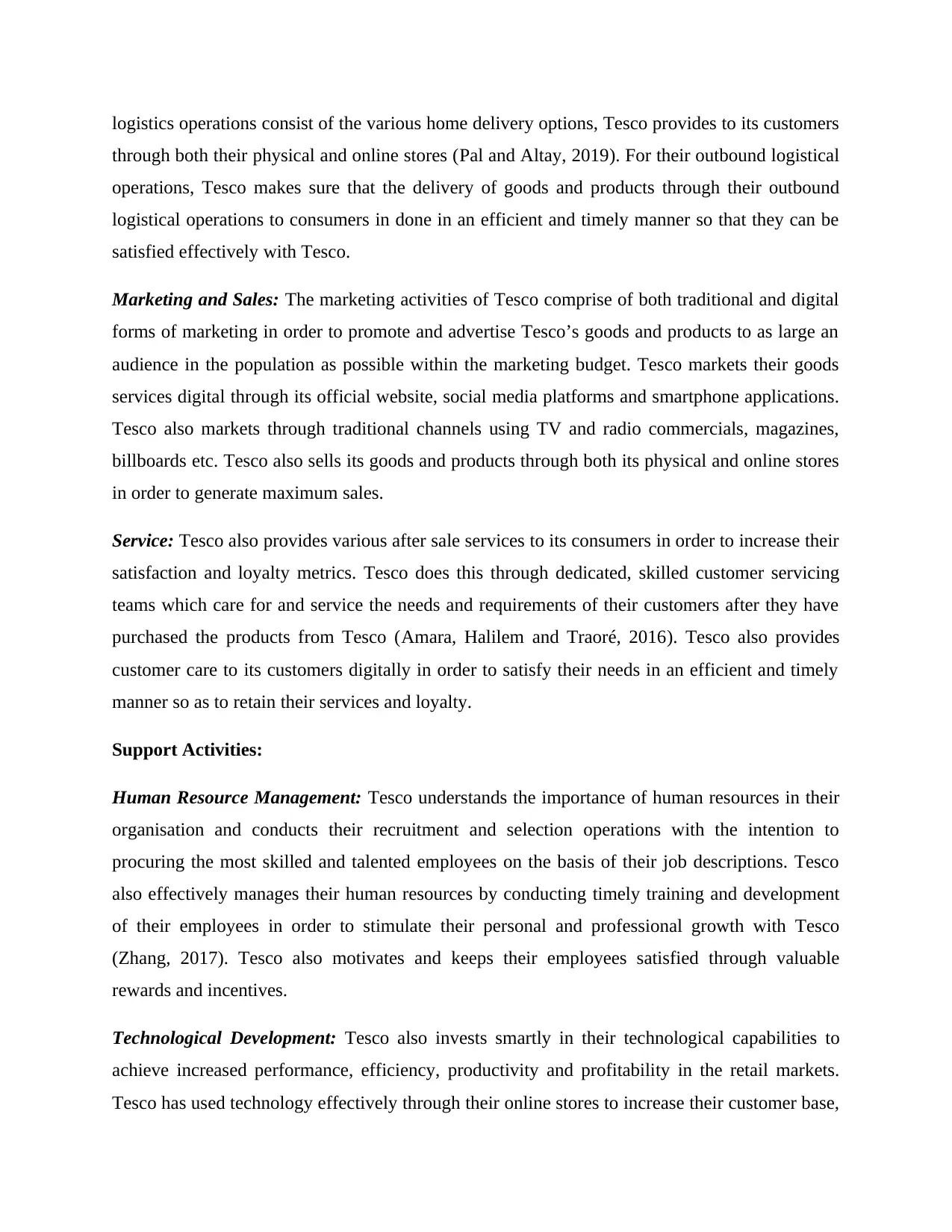
logistics operations consist of the various home delivery options, Tesco provides to its customers
through both their physical and online stores (Pal and Altay, 2019). For their outbound logistical
operations, Tesco makes sure that the delivery of goods and products through their outbound
logistical operations to consumers in done in an efficient and timely manner so that they can be
satisfied effectively with Tesco.
Marketing and Sales: The marketing activities of Tesco comprise of both traditional and digital
forms of marketing in order to promote and advertise Tesco’s goods and products to as large an
audience in the population as possible within the marketing budget. Tesco markets their goods
services digital through its official website, social media platforms and smartphone applications.
Tesco also markets through traditional channels using TV and radio commercials, magazines,
billboards etc. Tesco also sells its goods and products through both its physical and online stores
in order to generate maximum sales.
Service: Tesco also provides various after sale services to its consumers in order to increase their
satisfaction and loyalty metrics. Tesco does this through dedicated, skilled customer servicing
teams which care for and service the needs and requirements of their customers after they have
purchased the products from Tesco (Amara, Halilem and Traoré, 2016). Tesco also provides
customer care to its customers digitally in order to satisfy their needs in an efficient and timely
manner so as to retain their services and loyalty.
Support Activities:
Human Resource Management: Tesco understands the importance of human resources in their
organisation and conducts their recruitment and selection operations with the intention to
procuring the most skilled and talented employees on the basis of their job descriptions. Tesco
also effectively manages their human resources by conducting timely training and development
of their employees in order to stimulate their personal and professional growth with Tesco
(Zhang, 2017). Tesco also motivates and keeps their employees satisfied through valuable
rewards and incentives.
Technological Development: Tesco also invests smartly in their technological capabilities to
achieve increased performance, efficiency, productivity and profitability in the retail markets.
Tesco has used technology effectively through their online stores to increase their customer base,
through both their physical and online stores (Pal and Altay, 2019). For their outbound logistical
operations, Tesco makes sure that the delivery of goods and products through their outbound
logistical operations to consumers in done in an efficient and timely manner so that they can be
satisfied effectively with Tesco.
Marketing and Sales: The marketing activities of Tesco comprise of both traditional and digital
forms of marketing in order to promote and advertise Tesco’s goods and products to as large an
audience in the population as possible within the marketing budget. Tesco markets their goods
services digital through its official website, social media platforms and smartphone applications.
Tesco also markets through traditional channels using TV and radio commercials, magazines,
billboards etc. Tesco also sells its goods and products through both its physical and online stores
in order to generate maximum sales.
Service: Tesco also provides various after sale services to its consumers in order to increase their
satisfaction and loyalty metrics. Tesco does this through dedicated, skilled customer servicing
teams which care for and service the needs and requirements of their customers after they have
purchased the products from Tesco (Amara, Halilem and Traoré, 2016). Tesco also provides
customer care to its customers digitally in order to satisfy their needs in an efficient and timely
manner so as to retain their services and loyalty.
Support Activities:
Human Resource Management: Tesco understands the importance of human resources in their
organisation and conducts their recruitment and selection operations with the intention to
procuring the most skilled and talented employees on the basis of their job descriptions. Tesco
also effectively manages their human resources by conducting timely training and development
of their employees in order to stimulate their personal and professional growth with Tesco
(Zhang, 2017). Tesco also motivates and keeps their employees satisfied through valuable
rewards and incentives.
Technological Development: Tesco also invests smartly in their technological capabilities to
achieve increased performance, efficiency, productivity and profitability in the retail markets.
Tesco has used technology effectively through their online stores to increase their customer base,
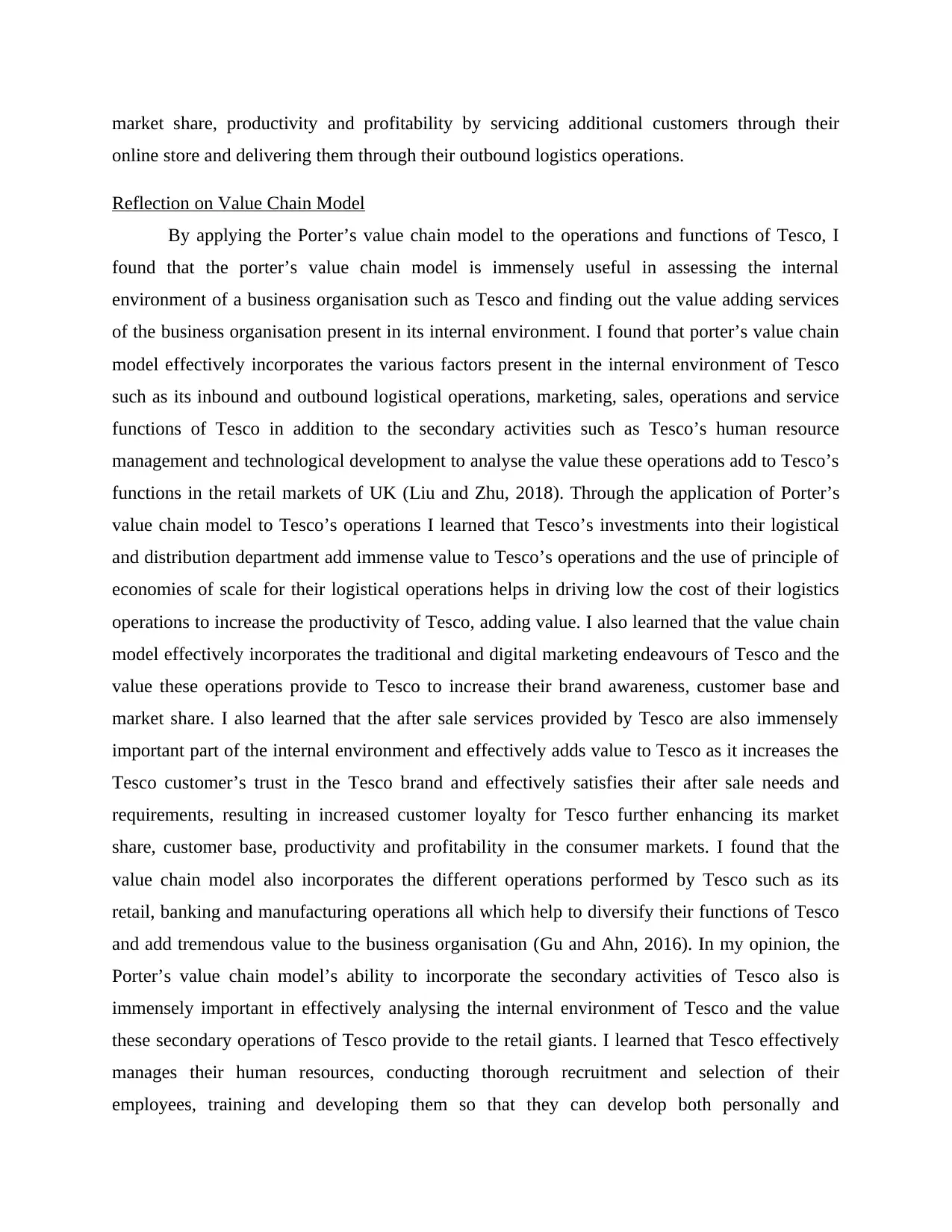
market share, productivity and profitability by servicing additional customers through their
online store and delivering them through their outbound logistics operations.
Reflection on Value Chain Model
By applying the Porter’s value chain model to the operations and functions of Tesco, I
found that the porter’s value chain model is immensely useful in assessing the internal
environment of a business organisation such as Tesco and finding out the value adding services
of the business organisation present in its internal environment. I found that porter’s value chain
model effectively incorporates the various factors present in the internal environment of Tesco
such as its inbound and outbound logistical operations, marketing, sales, operations and service
functions of Tesco in addition to the secondary activities such as Tesco’s human resource
management and technological development to analyse the value these operations add to Tesco’s
functions in the retail markets of UK (Liu and Zhu, 2018). Through the application of Porter’s
value chain model to Tesco’s operations I learned that Tesco’s investments into their logistical
and distribution department add immense value to Tesco’s operations and the use of principle of
economies of scale for their logistical operations helps in driving low the cost of their logistics
operations to increase the productivity of Tesco, adding value. I also learned that the value chain
model effectively incorporates the traditional and digital marketing endeavours of Tesco and the
value these operations provide to Tesco to increase their brand awareness, customer base and
market share. I also learned that the after sale services provided by Tesco are also immensely
important part of the internal environment and effectively adds value to Tesco as it increases the
Tesco customer’s trust in the Tesco brand and effectively satisfies their after sale needs and
requirements, resulting in increased customer loyalty for Tesco further enhancing its market
share, customer base, productivity and profitability in the consumer markets. I found that the
value chain model also incorporates the different operations performed by Tesco such as its
retail, banking and manufacturing operations all which help to diversify their functions of Tesco
and add tremendous value to the business organisation (Gu and Ahn, 2016). In my opinion, the
Porter’s value chain model’s ability to incorporate the secondary activities of Tesco also is
immensely important in effectively analysing the internal environment of Tesco and the value
these secondary operations of Tesco provide to the retail giants. I learned that Tesco effectively
manages their human resources, conducting thorough recruitment and selection of their
employees, training and developing them so that they can develop both personally and
online store and delivering them through their outbound logistics operations.
Reflection on Value Chain Model
By applying the Porter’s value chain model to the operations and functions of Tesco, I
found that the porter’s value chain model is immensely useful in assessing the internal
environment of a business organisation such as Tesco and finding out the value adding services
of the business organisation present in its internal environment. I found that porter’s value chain
model effectively incorporates the various factors present in the internal environment of Tesco
such as its inbound and outbound logistical operations, marketing, sales, operations and service
functions of Tesco in addition to the secondary activities such as Tesco’s human resource
management and technological development to analyse the value these operations add to Tesco’s
functions in the retail markets of UK (Liu and Zhu, 2018). Through the application of Porter’s
value chain model to Tesco’s operations I learned that Tesco’s investments into their logistical
and distribution department add immense value to Tesco’s operations and the use of principle of
economies of scale for their logistical operations helps in driving low the cost of their logistics
operations to increase the productivity of Tesco, adding value. I also learned that the value chain
model effectively incorporates the traditional and digital marketing endeavours of Tesco and the
value these operations provide to Tesco to increase their brand awareness, customer base and
market share. I also learned that the after sale services provided by Tesco are also immensely
important part of the internal environment and effectively adds value to Tesco as it increases the
Tesco customer’s trust in the Tesco brand and effectively satisfies their after sale needs and
requirements, resulting in increased customer loyalty for Tesco further enhancing its market
share, customer base, productivity and profitability in the consumer markets. I found that the
value chain model also incorporates the different operations performed by Tesco such as its
retail, banking and manufacturing operations all which help to diversify their functions of Tesco
and add tremendous value to the business organisation (Gu and Ahn, 2016). In my opinion, the
Porter’s value chain model’s ability to incorporate the secondary activities of Tesco also is
immensely important in effectively analysing the internal environment of Tesco and the value
these secondary operations of Tesco provide to the retail giants. I learned that Tesco effectively
manages their human resources, conducting thorough recruitment and selection of their
employees, training and developing them so that they can develop both personally and
Paraphrase This Document
Need a fresh take? Get an instant paraphrase of this document with our AI Paraphraser
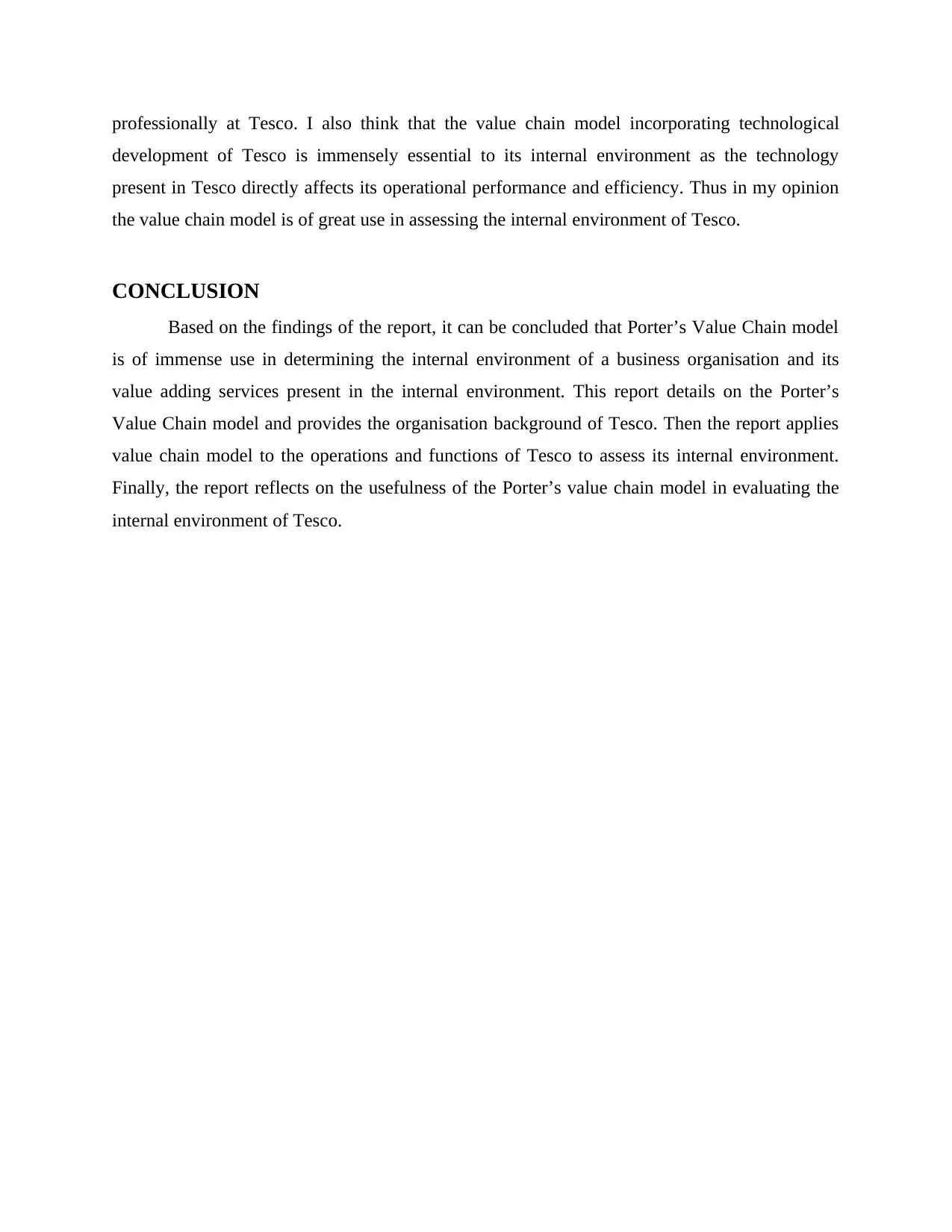
professionally at Tesco. I also think that the value chain model incorporating technological
development of Tesco is immensely essential to its internal environment as the technology
present in Tesco directly affects its operational performance and efficiency. Thus in my opinion
the value chain model is of great use in assessing the internal environment of Tesco.
CONCLUSION
Based on the findings of the report, it can be concluded that Porter’s Value Chain model
is of immense use in determining the internal environment of a business organisation and its
value adding services present in the internal environment. This report details on the Porter’s
Value Chain model and provides the organisation background of Tesco. Then the report applies
value chain model to the operations and functions of Tesco to assess its internal environment.
Finally, the report reflects on the usefulness of the Porter’s value chain model in evaluating the
internal environment of Tesco.
development of Tesco is immensely essential to its internal environment as the technology
present in Tesco directly affects its operational performance and efficiency. Thus in my opinion
the value chain model is of great use in assessing the internal environment of Tesco.
CONCLUSION
Based on the findings of the report, it can be concluded that Porter’s Value Chain model
is of immense use in determining the internal environment of a business organisation and its
value adding services present in the internal environment. This report details on the Porter’s
Value Chain model and provides the organisation background of Tesco. Then the report applies
value chain model to the operations and functions of Tesco to assess its internal environment.
Finally, the report reflects on the usefulness of the Porter’s value chain model in evaluating the
internal environment of Tesco.
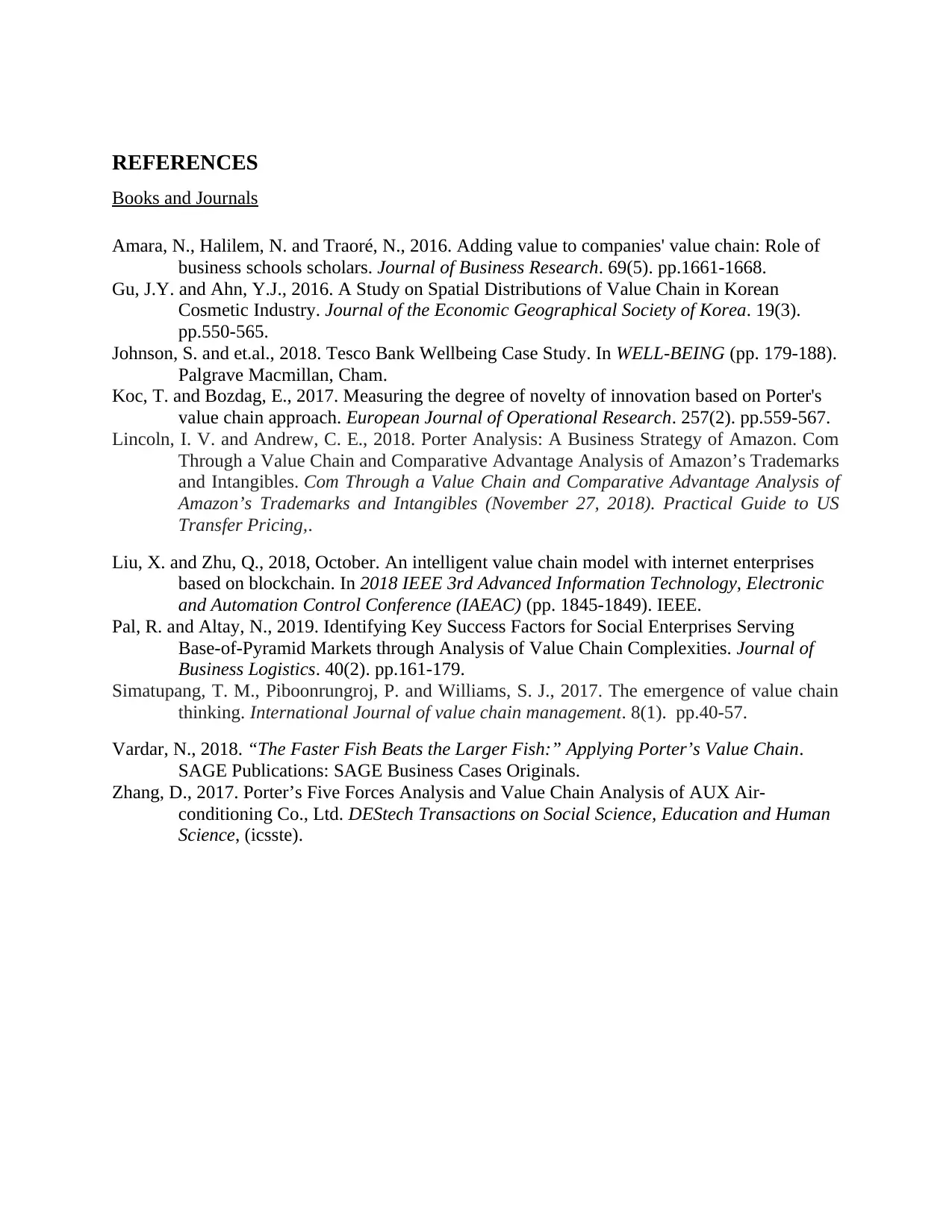
REFERENCES
Books and Journals
Amara, N., Halilem, N. and Traoré, N., 2016. Adding value to companies' value chain: Role of
business schools scholars. Journal of Business Research. 69(5). pp.1661-1668.
Gu, J.Y. and Ahn, Y.J., 2016. A Study on Spatial Distributions of Value Chain in Korean
Cosmetic Industry. Journal of the Economic Geographical Society of Korea. 19(3).
pp.550-565.
Johnson, S. and et.al., 2018. Tesco Bank Wellbeing Case Study. In WELL-BEING (pp. 179-188).
Palgrave Macmillan, Cham.
Koc, T. and Bozdag, E., 2017. Measuring the degree of novelty of innovation based on Porter's
value chain approach. European Journal of Operational Research. 257(2). pp.559-567.
Lincoln, I. V. and Andrew, C. E., 2018. Porter Analysis: A Business Strategy of Amazon. Com
Through a Value Chain and Comparative Advantage Analysis of Amazon’s Trademarks
and Intangibles. Com Through a Value Chain and Comparative Advantage Analysis of
Amazon’s Trademarks and Intangibles (November 27, 2018). Practical Guide to US
Transfer Pricing,.
Liu, X. and Zhu, Q., 2018, October. An intelligent value chain model with internet enterprises
based on blockchain. In 2018 IEEE 3rd Advanced Information Technology, Electronic
and Automation Control Conference (IAEAC) (pp. 1845-1849). IEEE.
Pal, R. and Altay, N., 2019. Identifying Key Success Factors for Social Enterprises Serving
Base‐of‐Pyramid Markets through Analysis of Value Chain Complexities. Journal of
Business Logistics. 40(2). pp.161-179.
Simatupang, T. M., Piboonrungroj, P. and Williams, S. J., 2017. The emergence of value chain
thinking. International Journal of value chain management. 8(1). pp.40-57.
Vardar, N., 2018. “The Faster Fish Beats the Larger Fish:” Applying Porter’s Value Chain.
SAGE Publications: SAGE Business Cases Originals.
Zhang, D., 2017. Porter’s Five Forces Analysis and Value Chain Analysis of AUX Air-
conditioning Co., Ltd. DEStech Transactions on Social Science, Education and Human
Science, (icsste).
Books and Journals
Amara, N., Halilem, N. and Traoré, N., 2016. Adding value to companies' value chain: Role of
business schools scholars. Journal of Business Research. 69(5). pp.1661-1668.
Gu, J.Y. and Ahn, Y.J., 2016. A Study on Spatial Distributions of Value Chain in Korean
Cosmetic Industry. Journal of the Economic Geographical Society of Korea. 19(3).
pp.550-565.
Johnson, S. and et.al., 2018. Tesco Bank Wellbeing Case Study. In WELL-BEING (pp. 179-188).
Palgrave Macmillan, Cham.
Koc, T. and Bozdag, E., 2017. Measuring the degree of novelty of innovation based on Porter's
value chain approach. European Journal of Operational Research. 257(2). pp.559-567.
Lincoln, I. V. and Andrew, C. E., 2018. Porter Analysis: A Business Strategy of Amazon. Com
Through a Value Chain and Comparative Advantage Analysis of Amazon’s Trademarks
and Intangibles. Com Through a Value Chain and Comparative Advantage Analysis of
Amazon’s Trademarks and Intangibles (November 27, 2018). Practical Guide to US
Transfer Pricing,.
Liu, X. and Zhu, Q., 2018, October. An intelligent value chain model with internet enterprises
based on blockchain. In 2018 IEEE 3rd Advanced Information Technology, Electronic
and Automation Control Conference (IAEAC) (pp. 1845-1849). IEEE.
Pal, R. and Altay, N., 2019. Identifying Key Success Factors for Social Enterprises Serving
Base‐of‐Pyramid Markets through Analysis of Value Chain Complexities. Journal of
Business Logistics. 40(2). pp.161-179.
Simatupang, T. M., Piboonrungroj, P. and Williams, S. J., 2017. The emergence of value chain
thinking. International Journal of value chain management. 8(1). pp.40-57.
Vardar, N., 2018. “The Faster Fish Beats the Larger Fish:” Applying Porter’s Value Chain.
SAGE Publications: SAGE Business Cases Originals.
Zhang, D., 2017. Porter’s Five Forces Analysis and Value Chain Analysis of AUX Air-
conditioning Co., Ltd. DEStech Transactions on Social Science, Education and Human
Science, (icsste).
1 out of 9
Related Documents
Your All-in-One AI-Powered Toolkit for Academic Success.
+13062052269
info@desklib.com
Available 24*7 on WhatsApp / Email
![[object Object]](/_next/static/media/star-bottom.7253800d.svg)
Unlock your academic potential
© 2024 | Zucol Services PVT LTD | All rights reserved.





